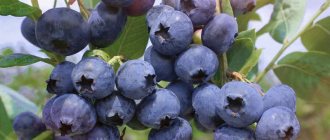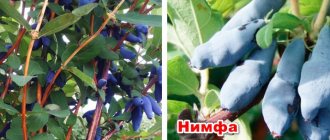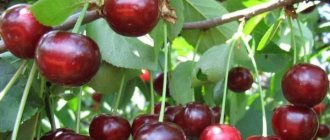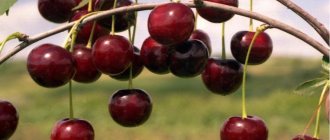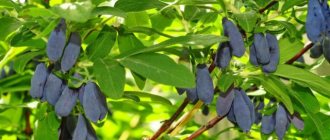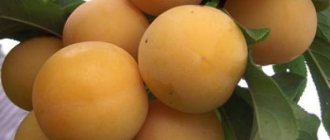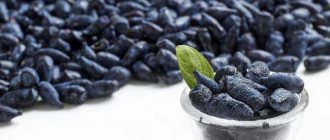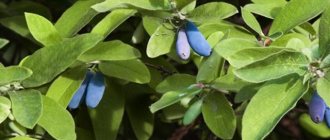Description of the variety
Unlike the low-growing forest blueberry with small berries, which is common for residents of the middle zone, the Bluejay garden blueberry is a powerful shrub plant, the height of which can reach 2 meters.
With proper care, the Bluejay blueberry variety produces thick, light brown shoots that turn brown as they grow. The stems are covered with single, unpaired ellipsoidal leaves. The dimensions of the leaf plates are large - from 8 to 10 cm. Their color is rich green. By the end of the season, the leaves fade somewhat in the sun and become lighter or turn red.
Among the characteristics of Bluejay blueberries, both breeders and gardeners note its hardiness and ability to withstand frosts down to –35˚C under light cover. Therefore, the variety can be grown throughout almost the entire territory of Russia, with the exception of regions located in high northern latitudes.
Growing Bluejay blueberries involves some difficulties, which are primarily associated with their demanding soil composition. The plant prefers loose, well-breathable, and at the same time acidified and moist soils. Simply put, soils that are as close as possible in composition and mechanical properties to natural ones.
Interesting fact!
Bluejay blueberries were obtained by crossing four varieties, both tall varieties, growing mainly in dense forests of the USA and Canada, and garden species. From the first, the plant inherited its demands for podzolic soils with high acidity. Secondly, productivity and excellent taste.
In the photo of the blueberry variety Bluejay, taken during fruiting, it is clearly visible that the bush is covered with long tassels with berries of light blue or gray-blue color with a waxy coating. The shape of the berries resembles blueberries, only large. Their diameter can reach 1.8-2.0 cm, and the weight of one fruit averages 2 grams.
Bluejay blueberries have thick skin and juicy pulp with an original sweet-tart taste and a distinct aroma.
Judging by the reviews of experienced gardeners, Bluejay blueberries require close attention when growing. But if you organize the process correctly, it will not require much time. And in comparison with other varieties, it will look like a completely unassuming crop. Like most blueberry varieties, Bluejay requires water balance, timely and correct pruning of shoots, fertilizing, and shallow but regular loosening of the soil.
Ripening time
Plan to harvest the first harvest 3-4 years after planting.
There won’t be many berries, but in a couple of years the bush will reach full fruit production. Up to 8 kg of berries are harvested from an adult plant per year. Berries can be stored fresh for no more than 2 weeks. Use the refrigerator or other cool place for this. Wash only before use, this will extend the shelf life of the harvested crop. Important! The biggest challenge in growing blueberries is the birds. They actively consume berries
With just a couple of bushes, you can easily cover them with bird netting in July when the fruits begin to ripen.
To know if the berries are ripe, simply taste them. After they acquire the color characteristic of the variety (blue), they begin to gain sweetness. Since blueberries have rather dense pulp, you cannot visually tell about their ripeness. Try them day after day, and when they seem sweet enough to you, start harvesting.
The berries are consumed fresh, frozen, dried, or prepared as puree or juice. They are also used to make jams, jellies, pies, muffins, and other baked goods. If there are a lot of berries, you can also make homemade wine, juice or liqueur.
Blueberries are a fairly unpretentious plant that adapts well to temperate and cold climates. Stable fruiting, excellent taste of the fruits and their medicinal properties are excellent arguments for trying to grow this shrub on your own plot.
Features of reproduction
The main methods of propagating Bluejay blueberries:
- Seeds. The process takes a long time and with an unpredictable result is practically meaningless.
- By cuttings. After the end of the growing season, a powerful shoot is selected, cut out, divided into cuttings with 2-3 buds on each. Planting material is planted in containers with a mixture of turf soil and peat. Planting in a permanent place is possible after two years.
Most gardeners prefer to propagate Bluejay blueberries through root shoots or division of an adult bush. In this case, there is no need to store seedlings for a long period of time.
Collection and storage of blueberries
Being a rather delicate berry, blueberries love to be carefully picked. And although large farms use combines for harvesting, manual harvesting is always more popular and well paid. The best containers for collection are containers with a lid, plastic or bark. Shelf life: up to 3 months in a cold room (temperature up to +12°C, without cold air).
Did you know? In Scandinavian countries, a hundred years ago blueberries were stored in birch bark boxes with a layer of moss at the bottom. To preserve the berries, they were doused with fish oil.
If you need to preserve the berries for a longer time, the temperature in the chambers is reduced to +2°C, but this storage method usually works for industrial warehouses, and not for amateur premises. An excellent method for storing berries is freezing - when frozen, they are stored until the next harvest. You can also grind the blueberries with sugar or pour in sugar syrup.
How to plant correctly
When planting perennials such as Bluejay blueberries, you should remember that choosing the right location and following the rules makes caring for the plant much easier.
Bluejay blueberries are best grown in sunny, windless locations. It is difficult to find a place in a garden plot with soil typical of a forest or wetland area. Therefore, the holes are prepared in advance.
Interesting fact!
Under natural conditions, blueberries can live up to 90 years. The lifespan of garden varieties is almost two times shorter. However, with proper care, bushes will be able to please gardeners with a bountiful harvest for 35-45 years.
Bluejay blueberries are planted in holes with a depth and diameter of about 60-70 cm.
- On heavy, clayey soils, a drainage layer of broken bricks is installed.
- Next, a nutrient layer is laid. A mixture of peat and pine needles or a mixture of peat and rotted sawdust is suitable for it. Layer thickness 10-15 cm.
- They make a kind of ridge of peat about 15 cm high. The seedlings are planted on it.
- The root collar of the Bluejay seedling is buried to a height of 4-6 cm.
Planting is carried out either in the fall in regions with a mild climate, or in the spring in areas with harsh winters. When planting Bluejay blueberries in the spring, all inflorescences are removed in the first season, giving the plant time to take root and gain strength for further development.
Bluejay blueberries: growing an early ripening variety in the garden
Blueberries can still rarely be found in Russian gardens, but they predict a great future for this crop and even call it a competitor to black currants. It is not surprising that this berry has been gaining popularity recently, since experts have bred a huge number of varieties with excellent taste and decorative qualities. One of them is Bluejay blueberry. It is frost-resistant and has immunity to many diseases to which the crop is susceptible. In addition, Bluejay berries ripen much earlier than the fruits of other popular blueberry varieties, which is an undoubted advantage of the plant and makes it a welcome guest in the garden plot.
Growing rules
When describing the rules of agricultural technology for highbush blueberries of the Bluejay variety, the main emphasis is on watering and fertilizing.
- Water the bushes once every three days, adding up to 10 liters of water under the roots. During hot and dry periods, it is useful to spray the plants with water. Mulching the root zone with sawdust or peat will also help retain moisture at the roots.
- Organic feeding of the Bluejay variety is carried out once a year - in the spring, before the start of the growing season.
- In the future, fertilizers are used, which include phosphorus, potassium and magnesium.
- Periodically, Bluejay blueberries are watered with acidified water. For these purposes, use 9% table vinegar at the rate of 100 ml per 10 liters of water or a solution of citric acid prepared from one bucket of water and a tablespoon of acid.
In a separate row there is pruning of shoots and formation of a blueberry bush of the Bluejay variety. The first pruning is recommended 3 years after planting. All underdeveloped shoots less than 30 cm high, as well as shoots growing inside the bush or creeping along the ground, are removed. It is preferable to carry out this treatment in the autumn.
Blueberry care
Despite the high frost resistance, in winter the shrub needs additional protection. For this purpose, covering material is used. The spruce branches can protect the blueberry bush from a small amount of snow.
If the winter has little snow and there is frost outside, then snow is a means of protecting the plant. These methods can protect blueberry bushes from low temperatures and subsequent freezing in winter.
For better plant development, blueberries should be grown in moist soil. It is also advisable to take care of groundwater drainage. To do this, drainage should be done. Bluejay blueberries do not tolerate drought, so the plant needs careful and abundant irrigation.
Watering
Usually blueberries are irrigated twice in seven days with fifteen liters of water per bush. Every fourteen days, add 100 milliliters of table vinegar to ten liters of water.
The most important period of watering is the time of fruiting of the variety (mid-to-late summer). If you don’t take care of your blueberries at this time and don’t water them at the right time, you may lose your harvest this and next year.
Top dressing
To feed Bluejay blueberries, fertilizers and their complexes are selected that will oxidize the soil. For beginning summer residents and gardeners, the best option would be special fertilizers for coniferous and heather plants.
Thanks to ready-made special fertilizer complexes, the gardener does not have to think about what to add so that the blueberries receive enough superphosphate, ammonium sulfate, urea, and potassium sulfate. The soil is fertilized three times a year.
You need to feed the plant at the moment when the buds begin to bloom. The next feeding is carried out at the moment of fruit formation. And the last time fertilizer is applied when the berries ripen.
Trimming
The shrub is pruned for the first time three years after it is planted on the site. Since it is by this time that the main branches and shoots should begin to form. To properly perform pruning, it is necessary to remove all small (less than forty centimeters) branches from the lower part of the bush.
The next pruning is done in the spring. It is worth paying attention to the fact that it is performed before the buds begin to bloom. During the second procedure, all weak shoots growing in the center of the bush or too spreading shoots should be removed.
In the sixth year of the bush’s life, pruning is carried out in order to rejuvenate the tree. After this pruning, only young and strong shoots should remain, which can form a new “skeleton” of the bush. Accordingly, all old branches must be deleted.
Treatment against diseases and pests
And finally, it’s worth talking about the most common pests and diseases, their symptoms and methods of control:
- Khrushchev or May beetle. Insect larvae feed on blueberry leaves and roots, as a result of which the bush simply does not survive. As soon as you find the cockchafer on your bushes, buy special preparations: Inta-Virom or Actellik.
- The blueberry codling moth is a caterpillar that eats berries from the inside, causing them to dry out and fall off. The pest lays eggs in fruit ovaries. To combat such pests, the bushes are sprayed with Actellik or Fufanon (the action is repeated after ten days).
- Gray rot. The berries are covered with gray fluff. To treat the disease, the plant is treated with Fundazol or Topaz.
- Septoria blight is a disease in which rusty spots appear on leaves. To combat the disease, a one percent solution of Bordeaux mixture is used.
- Coccomycosis. With this disease, spots similar to septoria appear. After their formation, they grow and merge into one spot. The reverse side of the leaf becomes covered with fluff, as with gray rot. Fundazol is used to treat and prevent the disease.
Diseases and pests
Among the diseases affecting the Bluejay blueberry variety, the most dangerous are fungal diseases. Among them: coccomycosis and septoria. They affect leaf blades. They respond well to treatment with fungicides and copper-containing compounds. But you should not process the bushes during fruiting. Among the safest drugs, phytosporin should be noted. After treating plants with this preparation, you can pick berries a week later.
A more unpleasant event will be the laying of larvae among the roots of blueberries by the cockchafer. They feed on both young roots and leaves. The fight against them is a little easier, since the first manifestations in the form of dried shoots are noticeable at the end of May. If pests appear, you need to loosen the soil under the Bluejay blueberry bushes and treat it with insecticides.
Useful properties and contraindications
Blueberries of the Hardy Blue variety have a positive effect on human health. Eating berries helps strengthen the immune system, so resistance to viruses and infections is developed. If you introduce the fruits of this variety into your diet, you can promote the formation of blood vessels, reduce the risk of thrombosis, and prevent heart attack and stroke.
Blueberries promote memory development and improve brain function, so it is recommended to be consumed by those people whose work involves mental activity (teachers, doctors, journalists, programmers). If you suffer from pressure changes, then 40–50 g of berries per day will help cope with unpleasant symptoms (dizziness, nausea, decreased activity).
Important! If you exceed the recommended standards, you may experience allergic reactions (rashes, redness of the skin, difficulty breathing). Blue fruits help increase metabolism, due to which waste and toxins are quickly eliminated from the body.
Some women use blueberries for cosmetic procedures. Thanks to the abundant amount of vitamins and minerals, the fruits help get rid of rashes and wrinkles on the skin. They also help strengthen hair and nail plates.
Blue fruits help increase metabolism, due to which waste and toxins are quickly eliminated from the body. Some women use blueberries for cosmetic procedures. Thanks to the abundant amount of vitamins and minerals, the fruits help get rid of rashes and wrinkles on the skin. They also help strengthen hair and nail plates.
- Contraindications include:
- gastritis and stomach ulcers;
- individual intolerance;
- the use of drugs that are aimed at the formation of platelets (blueberries have the opposite effect).
Reviews from gardeners
Oleg, 34 years old, Samara I read a lot of reviews about Bluejay blueberries. Both good and bad. I'm great. It's been growing for five years. Doesn't cause much trouble. Trim, water and cover for the winter. True, I don’t expect a stunning harvest from it either. There will be enough for the children to enjoy and it will be good. But it’s enough for both compote and pie.
Svetlana, 40 years old, Taganrog Blue Jay blueberries were planted 3 years ago. So far everything is according to plan. This year it bloomed for the first time. There are a lot of ovaries. We hope for a good harvest. I am a pastry chef myself and I already have so many ideas for decorating cakes.
Varieties for cultivation in certain regions
Among the many varieties of blueberries, you can choose those that can successfully grow in specific regions. Climate, soil quality and other location features influence the choice of breeding product for your garden.
Important! Blueberries should not be fed with organic fertilizers. After all, they make the soil alkaline, and this crop prefers acidic soils.
In the middle zone
In the middle zone, where cold winters are not uncommon, the following have proven themselves best:
- Bluecrop.
- Patriot.
- Bonus, which is a variety whose fruits ripen at the end of August and provide a yield of about 6 kg. The plant can overwinter in frosts down to -29ºС.
- Blugold.
- Duke.
- Erliblue.
- Spartan.
- Northland.
- Darrow.
- Bluray, whose bushes rise to a height of 1.8 m, and the yield is 7 kg. These blueberries can withstand temperatures as low as -34ºC.
In Belarus
The most cultivated variety in Belarus is Bluecrop, which was already discussed above.
Also popular in this country:
- Patriot.
- Blueetta is an early, high-yielding bush that allows you to pick berries with aromatic pulp that are distinguished by a very good taste already at the very beginning of July. Productivity reaches 9 kg.
- Chanticleer, an early ripening variety that produces 2 harvests during the season. Large fruits up to 2.2 cm in diameter have a wine-fruity taste.
- Erliblue.
- Blue Brigitte, abundantly producing fruits 1.5 cm in diameter with good taste.
- Boniface grows above 2 m and produces large fruits with a spicy taste and attractive aroma.
- Hannah Choice, it is also distinguished by its tall growth and good bush productivity. The ripe fruits can stay on the branches for a long time without falling off.
- Pink Lemonade and Pink Champagne, they are new products and are distinguished by the pink color of the fruit. Their taste combines honey tones and lemon sourness. The variety is able to tolerate moderate frosts.
In the Nizhny Novgorod region
The most popular in this Volga region are:
- Rancocas, distinguished by berries with very good gastronomic qualities, high productivity (up to 7 kg from 1 bush), winter hardiness, good transportability and resistance to diseases and pests.
- River.
- Sunrise.
- Puru.
- Duke.
- Erliblue.
In outskirts of Moscow
The best harvests in this region are brought by tall varieties of early and medium ripening, yielding up to 10 kg per bush.
Important! Blueberries of any type gain sweetness in warm and sunny summers. Rainy and cool weather gives the fruits excessive astringency
List of the most popular:
- Duke.
- Nelson, which is a medium-sized bush (up to 1.6 m), on which fruits up to 2 cm in diameter ripen. These berries have a sweet taste and good keeping quality. The productivity of 1 bush reaches 9 kg.
- Bluecrop.
- Northland.
- Brigitte Blue is a late maturing hybrid. Tall bush - 2.2 m. Medium-sized fruits have high gastronomic qualities. The productivity of the bush reaches 6 kg.
- Rancocas.
For the Black Earth Region
In this region with fertile soil and moderate frosts, the most popular blueberry varieties are:
- Elliot, which is a tall (up to 2.1 m in height) late-ripening hybrid, producing up to 6 kg of berries from 1 bush. Small fruits have good taste.
- Darrow.
- Liberty.
- Elizabeth, characterized by large (up to 2.2 cm in diameter) fruits with a sweet, but not cloying, taste and delicate aroma. The variety can withstand frosts down to -35ºС.
- Bluejay, which, according to gardeners, has the most exquisite taste among other varieties. It has very large berries, reaching 4 cm in diameter. Up to 6 kg of berries are harvested from a Bluejay bush.
- Aino, producing up to 7 kg of medium-sized but sweet fruits from 1 bush. The crop can tolerate frosts down to -35ºС.
- Blue Sweet, the fruits of which begin to ripen at the end of June and form a good harvest of up to 6 kg per bush. The berries exhibit a sweet taste and fruit weight is about 4 g.
- Bluecrop.
- Patriot.
- Bonus.
- Jorma, capable of wintering in short-term frosts down to -39ºС. It has large berries with a sweet and sour taste and a pleasant aftertaste.
- Northland.
- Rancocas.
- River.
- Sunrise.
Blueberries are confidently conquering their niche in the gardens of various regions. This is facilitated not only by the obvious quality of this crop, but also by the abundance of its varieties, which are actively bred by breeders.
Planting and care
Young blueberry bushes at the age of 1-2 years, with a height of 50 centimeters, are planted in open ground. In order for plants to bear fruit abundantly, they require constant care.
Timing and technology of planting
Young Toro blueberry bushes are planted in the spring, before buds open, or in the fall, at the end of the growing season. Plants grown in pots can be planted throughout the season. Planting is done as follows:
- holes measuring 60x60 centimeters are dug;
- drainage is laid out at the bottom;
- garden soil is mixed with peat and poured into the hole;
- the roots are carefully straightened and covered with substrate so that the root collar is buried no more than 5 centimeters;
- the bushes are watered and mulched.
If there is no peat, then instead you can use a soil mixture consisting of garden soil; land taken from under coniferous trees; as well as rotted pine or spruce needles. In addition, colloidal sulfur is used to deoxidize the soil in the garden, which is added in the fall to a depth of 10-15 centimeters at the rate of 1 kg/m².
Important! Blueberries will develop well and bear fruit only in acidic soils !
Frequency of crop irrigation
Toro blueberries are a moisture-loving crop, so they need to be watered often. In spring, the procedure is carried out, depending on weather conditions, 1-2 times a week. In summer, watering is important for the formation of flower buds for the next season. In autumn, watering is significantly reduced.
Fertilizer application
The bushes are fed several times a season. The first time - before the start of sap flow, with a complex fertilizer consisting of nitrogen, phosphorus, and potassium. The same composition is used for the next feeding, which is done during blueberry flowering, and again during active fruiting. At the beginning of autumn, fertilizer is applied to help strengthen the plant and gain strength before frost.
There is also a special fertilizer for blueberries on sale with instructions for use. Many gardeners like to feed their plantings with bone or dolomite meal and wood ash. For blueberries, these components will be detrimental, since they alkalize the soil, and the crop requires acidic soil.
Garden bed care
Care consists of timely watering, fertilizing, mulching the soil, and pruning. Adding peat, pine litter, and sawdust to the roots helps retain moisture in the soil, prevent the growth of weeds, and will also serve as a fertilizer for plants when rotting.
In order for the bushes to actively grow and bear fruit, starting from the second year of life, they begin to be fed.
From the same year, sanitary pruning is carried out, removing broken, diseased, frozen branches. Young growth is removed, which takes away the strength of the plant and also contributes to the formation of fungal diseases due to poor drying of morning dew on them. At the beginning of spring and at the end of summer, to increase the acidity of the soil, it can be spilled with a 9% vinegar solution (70 milliliters per bucket of water).
Rejuvenating and shaping pruning
To rejuvenate the plant, all branches older than 5 years are pruned. This procedure helps maintain fruiting. Formative pruning is needed to thin the crown from unnecessary branches that thicken the bush. It should be taken into account that the greatest yield is produced by shoots of the second year of life. Shoots that do not produce flower buds (blind) are removed.
Note! Pruning improves the illumination of the bush, which promotes the formation of large berries .
Preventative treatments
As a result of improper care, blueberries can be affected by fungal diseases. Most often this occurs from waterlogging of the soil by an inexperienced gardener, as well as as a result of excessive precipitation. To prevent diseases, blueberries are sprayed with various preparations, for example, Agricola or Iskra according to the instructions.
In addition, the bushes can be sprayed with copper-containing preparations, such as Bordeaux mixture, HOM, copper sulfate. To prepare 3% Bordeaux mixture at home, you need to take the following components:
- 300 grams of copper sulfate;
- 300 grams of lime.
Cooking process:
- Dilute lime in 3 liters of hot water, then add 2 liters of cold water;
- Mix copper sulfate with 1-2 liters of hot water, after it has cooled, bring the volume of liquid to 5 liters.
Each of the components is diluted separately, then the following order is observed: a solution of copper sulfate is added to the strained milk of lime. The mixture quickly loses its properties, so it must be used on the same day.
Sheltering bushes for the winter
Before frost sets in, young Toro blueberry bushes are bent to the ground and secured with ropes tied to metal arches. The structure is covered from above with canvas fabric, spunbond, and then spruce branches. The device must be reliable, otherwise the bushes may remain unprotected from bad weather. You should not cover the plants ahead of time: in the warmth, shoots may begin to grow, which will subsequently die from frost.
Bluejay: the history of the variety's creation
Highbush blueberries are a plant native to the dense forests and wetlands of North America, particularly in the eastern United States and eastern Canada. Wild blueberries also grow in Russian forests, but only species native to America were used to create cultivated varieties.
Until the 20th century, blueberries were not cultivated in private and industrial gardens, but breeders did a lot of work and in the middle of the last century, cultivated varieties and hybrids of this beautiful berry began to appear.
The Bluejay variety is a beautiful and powerful plant that can decorate a site
The North American highbush blueberry Bluejay was obtained in 1952 in the USA as a result of cross-pollination of forest forms and several cultivars, including:
- Pioneer,
- Brooks
- Stanley,
- Grower.
Bluejay was introduced into production in 1977, but today it is practically not used as an industrial crop, since farmers have obtained more productive varieties with sweeter and larger berries that have excellent transportability. However, Bluejay blueberries are most often recommended for growing in private gardens, since the variety has undoubted advantages.
